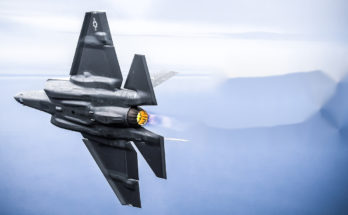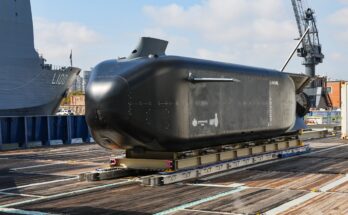by Dan Darling, International Military Markets Analyst, Forecast International.
In an ongoing marketing effort across Europe, Textron AirLand continues to demonstrate its Scorpion light attack/ISR (intelligence-surveillance-reconnaissance) aircraft to prospective buyers.
The latest pitch by Textron appears aimed at Bulgaria.
The targeting of Bulgaria by Textron is certainly a shrewd step by the company, as the aircraft – priced at $20 million per plane – presents an affordable alternative for a country that is one of the poorest in Europe, and yet hopes to revamp its Air Force’ Russian-legacy combat fleet with Western fighters.
A longstanding project to replace the Bulgarian Air Force’ MiG-29 Fulcrums (its 14 Su-25s were retired in 2012 and its six MiG-21s similarly withdrawn at a later date) has been bandied about in one form or another since 2006.
In a step aimed at meeting a NATO commitment made when Bulgaria joined the Alliance in March 2004, Sofia announced an international competition for the supply of 16 NATO-compatible fighters. By August 2006, a Request for Information (RFI) was sent to five potential candidates regarding a reduced-in-scope procurement of 12 fighters and four two-seat trainers. The five prospective platforms sought included Boeing’s F/A-18E/F, Dassault’s Rafale, the Eurofighter Typhoon, Sweden’s JAS 39C/D Gripen, and Lockheed Martin’s F-16C/D.
Soon, however, it became apparent to Sofia that funding such an acquisition in the face of funding shortfalls would be too problematic. Instead a cheaper alternative – the procurement of around eight second-hand F-16s from retired U.S. Air Force stocks – was examined, though nothing came of this.
As year after year passed with little progress forthcoming, questions surrounding the serviceability of the Air Force’ 1980s-vintage MiG-29s became paramount.
With an obligation to NATO to provide air-policing over its territory, Bulgaria confronted the issue of financing the maintenance on a fighter fleet it had originally intended to begin retiring in 2010. The unavoidable topic reared its head around the same time Russia undertook a stealth takeover of Ukraine’s Crimean Peninsula, exacerbating the gathering tension between the Kremlin and the West.
A maintenance and repair contract on the Bulgarian Air Force’ remaining 12 MiG-29s offered by Russian Aircraft Corporation MiG that would extend out to 2019 was – at BGN80 million ($45 million) – considered too expensive by Sofia.
Further, Bulgarian leadership – traditionally favorable towards Moscow – had soured on the idea of defense cooperation with Russia in light of the Kremlin’s antagonistic stance towards NATO and ongoing destabilization activities in Ukraine. Instead Bulgaria’s Defense Minister Nikolay Nenchev announced plans in early July to sign the maintenance-repair agreement with Poland.
While such a deal would ostensibly fulfill an immediate priority, there remains the longer-term question for Bulgaria of how best to revamp the Air Force’ combat fleet.
Nenchev has been pressing the government of Prime Minister Boyko Borisov to move forward on a fighter acquisition, pointing out that the price tag for retaining the MiG-29 fleet through 2029 will be BGN1.6 billion ($901 million) – making their retention more costly than a single squadron buy or lease of new or used NATO-standard fighters.
While a June 30 deadline to work on a draft bill regarding such an acquisition has expired, the issue is expected to be revisited by the cabinet shortly.
Nonetheless, Borisov has not been a voice of optimism regarding a potential fighter purchase – or any other defense acquisitions. Efforts by multiple defense ministers, political parties and Bulgaria’s president, Rosen Plevneliev, to bolster the country’s defense budget since August 2014 have been rebuffed by the prime minister. Recognizing Bulgaria’s listless economic performance and lack of financial resources, Borisov has stated that any fighter acquisition will remain untenable for up to 15 years. With a total defense budget currently hovering around a mere $600 million this stance hardly appears controversial.
Meanwhile, Nenchev has argued that the cabinet should agree on a fighter procurement that would be written into the armed forces’ long-term development strategy titled “Bulgaria in NATO and European Defense 2020”.
Clearly matters are nearing a head in Sofia regarding the airworthiness of its combat aircraft fleet and their long-term serviceability, particularly as the supply of spare-parts for MiG-29s relies on cannibalizing existing platforms or an agreement with Russia.
Should Borisov acquiesce to Defense Ministry requests for a fighter replacement then the most likely options for Bulgaria remain surplus F-16s from U.S. Air National Guard stocks, mothballed fighters from NATO-Europe allies, or possibly a lease/ lease-to-buy offer from Sweden regarding the JAS-39C/D Gripen similar to those inked with the Czech Republic and Hungary.
The Textron Scorpion, in the meantime, is being touted as a possible replacement for the Bulgarian Air Force’ Aero L-39ZA dual-use light strike fighter/trainers. Certainly the price tag for the Scorpion would hold great appeal to a cost-conscious government. But it would only meet a low-end requirement and not provide the requisite air-interdiction platform that would enable Bulgaria to no longer require Romanian and Turkish assistance in guarding its airspace.
Thus for now any purchase remains an either-or proposition for cash-deprived Bulgaria: either acquire the Scorpion for a low-end, short-term complement to the MiG-29s, or forego the Scorpion option for the aforementioned MiG-29 replacement alternatives.
Earlier in March, Nenchev testified to the Bulgarian parliament that as result of wear on the MiG fleet the country was at risk of soon having just two aircraft let to carry out air policing.
The clock, therefore, is ticking on a decision – any decision – regarding how best to meet the problem of Bulgaria’s declining combat aircraft capability.
For 50 years, Forecast International intelligence reports have been the aerospace and defense industry standard for accurate research, analysis, and projections. Our experienced analysts compile, evaluate, and present accurate data for decision makers. FI's market research reports offer concise analysis of individual programs and identify market opportunities. Each report includes a program overview, detailed statistics, recent developments and a competitive analysis, culminating in production forecasts spanning 10 or 15 years. Let our market intelligence reports be a key part of reducing uncertainties and mastering your specific market and its growth potential. Find out more at www.forecastinternational.com



